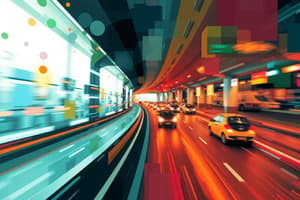Podcast
Questions and Answers
Intelligent traffic signal control is part of advanced traffic management strategies known as ______.
Intelligent traffic signal control is part of advanced traffic management strategies known as ______.
ITS
Vehicle-to-Vehicle (V2V) communication is a key aspect of connected and ______ vehicles.
Vehicle-to-Vehicle (V2V) communication is a key aspect of connected and ______ vehicles.
autonomous
Traveler Information Systems provide users with ______ travel information.
Traveler Information Systems provide users with ______ travel information.
real-time
Emerging technologies in ITS include the Internet of Things (IoT) and ______ intelligence.
Emerging technologies in ITS include the Internet of Things (IoT) and ______ intelligence.
______ considerations are important for the adoption of ITS.
______ considerations are important for the adoption of ITS.
ITS project planning involves methodologies for deployment and performance ______.
ITS project planning involves methodologies for deployment and performance ______.
Week 3 focuses on the background of ______.
Week 3 focuses on the background of ______.
Advanced Traveler Information Systems (ATIS) are one of the functional areas of ______.
Advanced Traveler Information Systems (ATIS) are one of the functional areas of ______.
The ______ includes federal, state, and local transportation departments.
The ______ includes federal, state, and local transportation departments.
Companies that develop and supply ITS technologies are referred to as ______.
Companies that develop and supply ITS technologies are referred to as ______.
Global positioning systems (GPS) are part of the ______ elements.
Global positioning systems (GPS) are part of the ______ elements.
Policymakers and ______ are key stakeholders in the ITS framework.
Policymakers and ______ are key stakeholders in the ITS framework.
______ management includes the planning and deployment of ITS technologies.
______ management includes the planning and deployment of ITS technologies.
Examples of telecommunication include both hardwire and ______ technologies.
Examples of telecommunication include both hardwire and ______ technologies.
The ______ is responsible for managing ITS technologies within their jurisdictions.
The ______ is responsible for managing ITS technologies within their jurisdictions.
Mobile devices are part of the ______ elements in transportation.
Mobile devices are part of the ______ elements in transportation.
Research and academic institutions contribute to ______ in the ITS sector.
Research and academic institutions contribute to ______ in the ITS sector.
Information and Communication Technology (ICT) Providers play a role in ______ ITS systems.
Information and Communication Technology (ICT) Providers play a role in ______ ITS systems.
Telecommunications companies, internet service providers, and wireless network operators are considered ______ providers.
Telecommunications companies, internet service providers, and wireless network operators are considered ______ providers.
Automakers that integrate ITS technologies ensure compatibility with transportation ______.
Automakers that integrate ITS technologies ensure compatibility with transportation ______.
Agencies responsible for real-time monitoring, coordination, and control of transportation networks are known as ______ management centers.
Agencies responsible for real-time monitoring, coordination, and control of transportation networks are known as ______ management centers.
______ centers conduct research, develop new ITS technologies, and provide educational programs.
______ centers conduct research, develop new ITS technologies, and provide educational programs.
The responsibilities of ICT providers include developing and maintaining necessary communication ______.
The responsibilities of ICT providers include developing and maintaining necessary communication ______.
ITS stakeholders help in collecting and analyzing data to make informed decisions related to ______ flow.
ITS stakeholders help in collecting and analyzing data to make informed decisions related to ______ flow.
Universities and research centers evaluate the impacts of ITS deployments and develop innovative ______ to transportation challenges.
Universities and research centers evaluate the impacts of ITS deployments and develop innovative ______ to transportation challenges.
Connected vehicle systems and advanced driver assistance features are examples of ______ technologies.
Connected vehicle systems and advanced driver assistance features are examples of ______ technologies.
The role of traffic management centers includes responding to ______ and optimizing transportation operations.
The role of traffic management centers includes responding to ______ and optimizing transportation operations.
ITS vehicle manufacturers contribute to the development of industry ______.
ITS vehicle manufacturers contribute to the development of industry ______.
Travel Advisory Systems (TAS) inform users about transportation updates including travel time, travel speed, and ______.
Travel Advisory Systems (TAS) inform users about transportation updates including travel time, travel speed, and ______.
The ITS architecture provides a standardized and comprehensive approach to the ______, deployment, and integration of various components.
The ITS architecture provides a standardized and comprehensive approach to the ______, deployment, and integration of various components.
The primary purpose of ITS Architecture is to ensure compatibility, integration, and coordinated deployment of ITS ______.
The primary purpose of ITS Architecture is to ensure compatibility, integration, and coordinated deployment of ITS ______.
One objective of ITS Architecture is to improve safety, reduce congestion, enhance mobility, and support ______ transportation solutions.
One objective of ITS Architecture is to improve safety, reduce congestion, enhance mobility, and support ______ transportation solutions.
Physical Architecture defines the physical components of the ITS system, such as vehicles, infrastructure, and communication ______.
Physical Architecture defines the physical components of the ITS system, such as vehicles, infrastructure, and communication ______.
Enabling technologies can be divided into several classes which include Data Acquisition, Data Processing, Data ______.
Enabling technologies can be divided into several classes which include Data Acquisition, Data Processing, Data ______.
Data ______ involves collecting information through devices like sensors and cameras.
Data ______ involves collecting information through devices like sensors and cameras.
Automatic Vehicle Identifiers and GPS based automatic vehicle locators are examples of data ______ devices.
Automatic Vehicle Identifiers and GPS based automatic vehicle locators are examples of data ______ devices.
During the ______ process, information collected at the data management center is processed and verified.
During the ______ process, information collected at the data management center is processed and verified.
The data collected is stored at a data ______ center.
The data collected is stored at a data ______ center.
CCTV cameras are part of the intelligent transportation ______ systems.
CCTV cameras are part of the intelligent transportation ______ systems.
Information utilization requires prompt and extensive data ______.
Information utilization requires prompt and extensive data ______.
Data processing can involve a data ______ process to consolidate information.
Data processing can involve a data ______ process to consolidate information.
Various hardware devices record data like traffic count, surveillance, and travel ______.
Various hardware devices record data like traffic count, surveillance, and travel ______.
Strategic planning in transportation relies on real-time ______ of data.
Strategic planning in transportation relies on real-time ______ of data.
Flashcards are hidden until you start studying
Study Notes
Traffic Management and Control
- Intelligent traffic signal control enhances the flow of vehicles by optimizing signal timings based on real-time conditions.
- Ramp metering regulates the rate of vehicles entering highways to prevent congestion and maintain smooth traffic flow.
- Variable speed limits adjust permissible speeds based on traffic, weather, and road conditions to improve safety and efficiency.
Traveler Information Systems
- In-vehicle and roadside information systems offer drivers real-time updates on traffic, road conditions, and possible delays.
- Mobile applications provide travelers with convenient access to live travel information, enabling better route planning and decision-making.
Connected and Autonomous Vehicles
- Vehicle-to-Vehicle (V2V) communication allows cars to exchange information, improving safety by alerting drivers to nearby hazards.
- Vehicle-to-Infrastructure (V2I) communication helps vehicles interact with traffic signals and road conditions for better navigation.
Emerging ITS Technologies
- The Internet of Things (IoT) enables devices to communicate and collect data, enhancing traffic management capabilities.
- Big data analytics process large volumes of travel data to identify patterns and optimize traffic systems.
- Cloud computing facilitates the storage and processing of data, ensuring scalability and accessibility for ITS applications.
- Artificial intelligence is leveraged to predict traffic patterns and enable automated responses.
ITS Planning, Implementation, and Evaluation
- Methodologies involve comprehensive project planning, deployment strategies, and performance assessment frameworks for ITS projects.
- Institutional considerations encompass the legal and policy frameworks that guide ITS adoption and implementation.
Grading Structure
- Midterm Exam contributes 25% to overall grade.
- Homework Assignments account for 20%.
- Term Paper is valued at 15%.
- Final Exam constitutes 40%.
- Total grading weight is 100%.
ITS Functional Areas
- Advanced Traffic Management Systems (ATMS) focus on managing and optimizing traffic flow.
- Advanced Traveler Information Systems (ATIS) provide up-to-date travel information to users.
- Commercial Vehicle Operations (CVO) streamline the movement of freight and enforce regulatory compliance.
- Advanced Vehicle Control Systems (AVCS) enhance vehicle safety and performance through technology.
- Advanced Public Transportation Systems (APTS) improve public transport operations and user experience.
ITS Infrastructure and Stakeholders
- Stakeholders include transportation agencies, technology providers, ICT providers, vehicle manufacturers, traffic management centers, researchers, and policymakers.
- Each stakeholder plays a critical role in developing, deploying, and maintaining ITS systems.
ITS Enabling Technologies
- Data acquisition involves collecting real-time data through various hardware devices, including sensors, cameras, and GPS locators.
- Data processing applies techniques to verify and consolidate information for effective operator use.
- Data communications ensure reliable transmission of data between ITS components.
- Information utilization focuses on delivering updates to travelers through advisory systems via electronic devices and network platforms.
ITS Architecture
- The architecture defines the organisational structure and relationships among various ITS components.
- It provides a standardized framework guiding agencies and stakeholders in developing and implementing ITS technologies.
- Objectives include enhancing safety, reducing traffic congestion, and supporting sustainable transport solutions.
System Components
- The physical architecture outlines essential components such as vehicles, infrastructure (traffic signals, sensors), and communication networks critical for ITS functions.
Studying That Suits You
Use AI to generate personalized quizzes and flashcards to suit your learning preferences.




